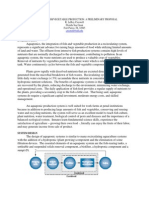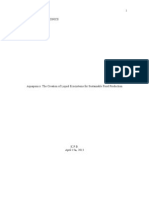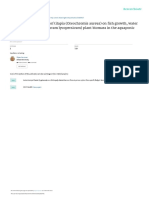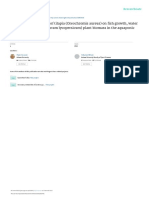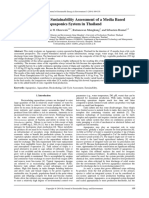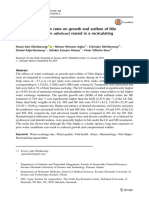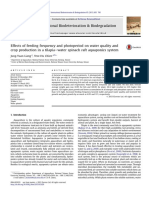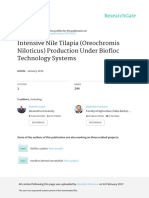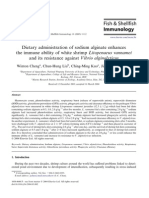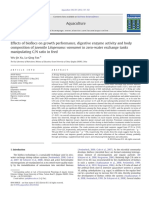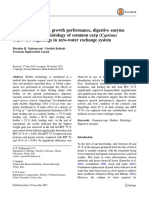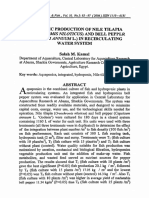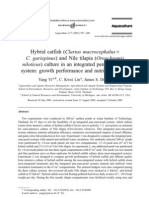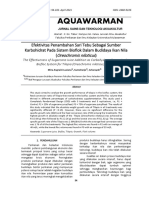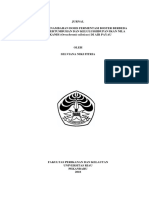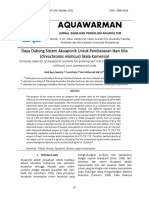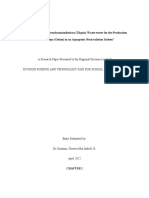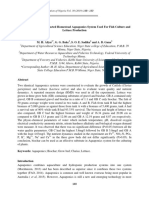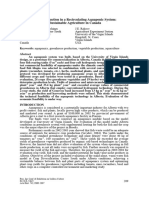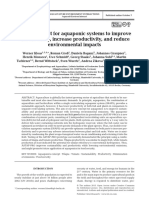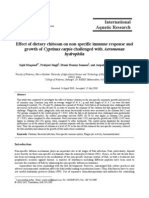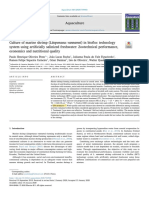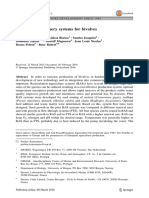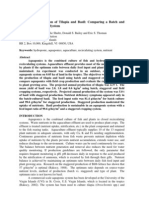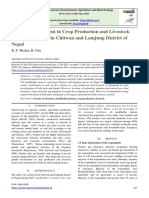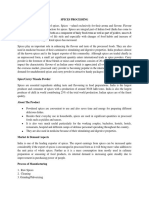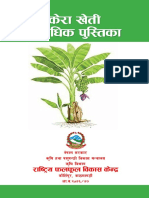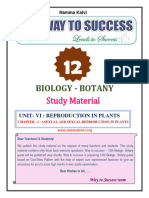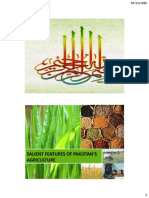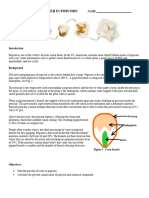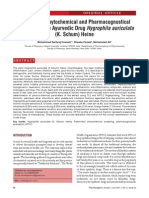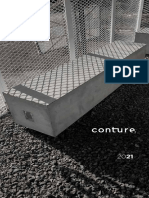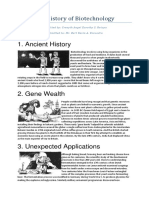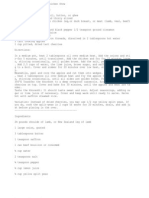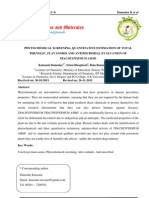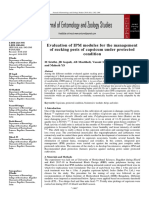Aureus) On Fish Growth, Water Quality and Tomato
Aureus) On Fish Growth, Water Quality and Tomato
Uploaded by
IJEAB JournalCopyright:
Available Formats
Aureus) On Fish Growth, Water Quality and Tomato
Aureus) On Fish Growth, Water Quality and Tomato
Uploaded by
IJEAB JournalOriginal Title
Copyright
Available Formats
Share this document
Did you find this document useful?
Is this content inappropriate?
Copyright:
Available Formats
Aureus) On Fish Growth, Water Quality and Tomato
Aureus) On Fish Growth, Water Quality and Tomato
Uploaded by
IJEAB JournalCopyright:
Available Formats
International Journal of Environment, Agriculture and Biotechnology (IJEAB) Vol-2, Issue-6, Nov-Dec- 2017
http://dx.doi.org/10.22161/ijeab/2.6.7 ISSN: 2456-1878
Role of stocking density of tilapia (Oreochromis
aureus) on fish growth, water quality and tomato
(Solanum lycopersicum) plant biomass in the
aquaponic system
Hijran Yavuzcan Yldz, Sleyman Bekcan
Department of Fisheries and Aquaculture, Faculty of Agriculture, Ankara University, Turkey
Abstract The present study reports the results of the Aquaponics, basically, the symbiotic growing of fish and
production of Nile tilapia (Oreochromis aureus) and vegetables in recirculating water systems is emerging as
tomato (Solanum lycopersicum) in the classical aquaponic one of the most important areas of sustainable agriculture.
system (one-loop) with different fish density. The Aquaponics is the systems that integrating aquaculture
experiment as the first scientific aquaponics study in recirculating production systems with hydroponics. With
Turkey was conducted at the Ankara University, Faculty of aquaponics dual production of both fish and plants is
Agriculture, using in-door, small-scale classical possible by using the water from the fish tanks for plant
aquaponic systems. Ninety six tilapia juveniles (O. aureus) growth. The essential elements of an aquaponic system
were stocked at different ratio; 25 kg/m3 (Group I), 35 consists of fish rearing tank, a suspended solid removal
kg/m3 (Group II) and 50 kg/m3 (Group III) and fed with component, a biofilter, a hydrponic component and a sump
45% raw protein feed at the level of 2% body weight for [4]. In the aquaponic system, nutrients, which are excreted
126 days. Fish density affected the fish growth parameters directly by the fish or generated by the microbial
and the most densiest group showed the best results in breakdown of organic wastes, are absorbed by plants
terms of fish growth and feed efficiency. Water quality cultured hydroponically. Through microbial
parameters measured fluctated during the experiment even decomposition, the insoluble fish metabolite and
the exceed of the optimal ranges for the fish. However, unconsumed feed are converted into soluble nutrients
tilapia tolerated the changes of water quality. Total plant which then can be absorbed by plant [5] . Fish feed
biomass was low with the various limiting factors provides most of the nutrients required for plant growth
including insufficient lighting of in-door aquaponics [6]. Aquaponics work on the principle of nitrogen cycle,
system and low level of water potassium. The results of where in dissolved waste generated from the production
this study clearly illustrate the fish stocking rate has an system is effectively converted to plant nutrients by
impact on total biomass in the aquaponics and in one-loop beneficial nitrifying bacteria. Plants can utilize these
aquaponics the water quality fluctation is the main nutrients for their growth [6, 7, 8]. Plants in hydroponics
challenging factor. and aquaponics grow more rapidly compared to their
Keywords aquaponics, tilapia, tomato, fish growth. counterparts which grow in the soil because the root
system is in direct contact with nutrients and nutrient
I. INTRODUCTION uptake is more efficient in an aqueous phase [9]. Water,
One of the main challenges of agriculture in 21th century energy and fish feed are the three main physical inputs for
to feed the growing population is finding more efficient aquaponic systems although the aquaponic operations vary
and sustainable food production systems and adapting to in size and type of production system [10]. Palm et al. [11]
climate change. There is also a gap in the availability of highlighted that economic sustainability of aquaponics
freshwater and land to increase the yield with minimal depends on a variety of factors including system and feed
environmental effect [1]. To overcome the problems that design, animal welfare and pathogen control. There is a
the worls is facing with such as water scarcity, soil need to establish the macro- and micronutrient proportion
degradation, climate change and the population increase that fish can release in the water for a given feed in a given
the aquaponics appear an alternative solution as the system; this depends on fish species, fish density,
aquaponics are an environmental friendly and sustainable temperature, and type of plants [12]. It is clear that feed
food production system [2,3]. and stocking rate of fish are directly related and to
maintain the balance between metabolic products the
www.ijeab.com Page | 2819
International Journal of Environment, Agriculture and Biotechnology (IJEAB) Vol-2, Issue-6, Nov-Dec- 2017
http://dx.doi.org/10.22161/ijeab/2.6.7 ISSN: 2456-1878
stocking rate is critical in the aquaponics as a reflection of where, Wt =Mean final fish weight, Wt0 =Mean initial fish
feed. Therefore, the present study was carried out to assess weight and t-t0 = number of days on feed
the production of Nile tilapia (Oreochromis aureus) and vi) Daily growth index DGI (%): DGI%= (final
tomato (Solanum lycopersicum) in the aquaponic system weight1/3 - initial weight1/3 ) 100/day
with different fish density.
. Table.1: Chemical composition of the feed
II. MATERIAL AND METHODS Component (%)
This research was carried out in the small-scale aquaponic Protein % 45,0 Digestible energy 4125
system with a grow bed form, producing tilapia (O. kcal/kg
aureus) and tomato (S. lycopersicum) in Ankara Lipid % 20,0 Metabolic energy 3742
University, Faculty of Agriculture, Department of kcal/kg
Fisheries and Aquaculture. Aquaponic system was Moisture % 8,5 Vitamin A IU/kg 5.000
installed in-door. Ash % 11,0 Vitamin D IU/kg 1.500
The protocol for the experiment was approved by the Cellulose % 3,0 Vitamin E IU/kg 100
ethics committee of the Ankara University with the Nitrogen free 12,5 Vitamin K IU/kg 20
reference number of 2014-2-9. extract %
Experimental set up Phosphorus 1,5 GE (Gross 5124
Ninety six tilapia juveniles (O. aureus) were stocked at % energy) kcal/kg
different ratio; 25 kg/m3 (Group I), 35 kg/m3 (Group II)
and 50 kg/m3 (Group III). Individual fish weight was 5-7 g At the end of the experiment, plant (S. lycopersicum) parts
at the beginning of the experiment. Fish were fed with were weighted separately (as leaf, stem and root) for
commercial rainbow trout feed with 45 % raw protein with determination of fresh and dry weight. For measuring dry
2% body weight for 126 days. Chemical composition of weight of the plant samples was dried in 65 C for 3 days.
the feed is presented in Table 1. The aquaponics Water Quality Measurements
experimental system comprises of a nine fish tank Water quality parameters in fish tanks were routinly
(80x60x50 cm) and nine plastic tanks (65x40x35 cm) measured. During the experimental period the water
filled with hydraton for vegetable beds. Each vegetation temperature was kept at 23C. Dissolved oxygen (DO),
tank planted with 4 plantlet (30-35 days old) of tomato (S. temperature (T) and pH were measured every week with
lycopersicum). Each fish tank was filled with 100 L of tap portable equipments. Other water quality parameters;
water and aerated continuously with air stone. Nitrifying ammonia (NH3), Nitrat (NO3-), Nitrit (NO2-) and
bacteria; Nitrosomonas europaea and Nitrobacter potassium (K) were measured every 15 days by using
winogradskyi were added to the system at the initial Standard Methods [13].
period. Experiments were run in three replicates. A Statistical Analysis
lighting system made of eight Ostram HO 80w/865 This experiment were conducted as completely
lumilux cool daylight fluorescent lamps was placed above randomized design with three replicates. Data were
the units. Water loss due to sampling and evaporation was analyzed by analysis of variance (ANOVA) with the SAS
replenished with the addition of distilled water. package. Duncans multiple-range test was used to
Analytic procedures compare differences among individual means. Treatment
After 126 days of rearing the fish was harvested and their effects were considered significant at p<0.05. Percentage
growth performance was measured with the parameters and ratio data were transformed to arcsine values prior to
using the formulas as below. analysis[14].
i) Feed Conversion Ratios (FCR): FCR= food
intake/ weight gain III. RESULTS
ii) Protein efficiency ratio (PER): (PER) = (Wt- Growth and production of tilapia in the aquaponic system
Wt0)/crude protein fed are given in Table 2. The mean group weight gain was
iii) Feed efficiency (FE): FE= weight gain/feed fed 544.157.9 in Group I (stocking rate: 25 kg/m 3),
iv) Specific growth rate (SGR%): SGR%= (lnWt 849.730.8 in the Group II (stocking rate: 35 kg/m3) and
lnWt0 x100) / t-t0 1003.349.8 for Group III (stocking rate: 50kg/m 3). The
where, lnWt = the natural logarithm of the final weight, differences in mean group weight gain were statistically
lnWt0 = the natural logarithm of the initial weight, t = time significant (p < 0.05) and the highest weight gain was in
(days) between lnWt and lnWt0 Group III with the highest fish density. Feed conversion
v) Average daily gain (ADG): ADG% = 100[Wt- ratio (FCR) differed among the groups (p < 0.05) however,
Wt0/Wt x (t-t0)]
www.ijeab.com Page | 2820
International Journal of Environment, Agriculture and Biotechnology (IJEAB) Vol-2, Issue-6, Nov-Dec- 2017
http://dx.doi.org/10.22161/ijeab/2.6.7 ISSN: 2456-1878
the FCR was similar in Group II and III. The FCR was value of 12.8330.829 %. Daily growth index (DGI)
higher in Group I than that of Group II and III. Thus, feed differed among the groups (p < 0.05) and the minimum
efficiency (FE) was lower in Group I. Protein efficiency DGI percentage was in Group I. Survival rate showed
ratio (PER) showed significant differences among the significant differences among the groups (p < 0.05) and
groups. PER was the lowest in Group I and the highest in was the highest in Group II.
Group III. Specific growth rate was higher in Group III.
Average daily growth was the highest in Group III with the
Table.2: The growth parameters of tilapia (O. aureus) in the aquaponics system by the stocking ratio
Experimental groups
Growth Parameters Group I Group II Group III
Stocking rate: 25 kg/m3 Stocking rate: 35 kg/m3 Stocking rate: 50
kg/m3
Mean group initial body weight (g) 44.9671.08b* 68.7330.994a 70.0673.18a
Mean group Final body weight (g) 589.058.4b 918.431.8a 1073.450.0a
1
Mean group weight gain (g) 544.157.9c 849.730.8b 1003.349.8a
Food Consumed (g)2 621.8723.0c 788.9012.1b 913.832.39a
Feed Conversion Ratios (FCR)1 1.16000.0777a 0.93000.0231b 0.91330.0406b
Feed efficiency (FE)1 0.87100.0618b 1.07650.0257a 1.09770.0516a
Protein Efficiency Ratio (PER)1 11.8281.26c 18.4710.669b 21.8121.08a
Specific Growth Rate (SGR %) 2.28910.0763b 2.31380.0176b 2.43660.0533a
Percentage average daily growth (ADG 10.7881.02b 11.0300.238b 12.8330.829a
%)
Daily growth index (DGI %) 4.29430.228c 5.01930.0815b 5.45830.145a
Survival (%) 80.9529.52a 96.9703.03b 85.71410.9a
*Values with different superscripts in a row differ significantly (p<0.05)
1 Expressed as the percent of the initial body weight after 126 days.
2 Moisture-free basis.
The tomato (S. lycopersicum) plant biomass as fresh and plant (p < 0.05). Final total weight values were the
dry weight of tomato plant leaf, stem and root branches maximum in Group III. Fresh and dry weight of total
were presented in Table 3. Significant differences were plant correlated with fish density (R2=0.92).
observed in the fresh weight and dry weight of tomato
Table.3: Biomass of tomato (S. lycopersicum) plants grown in the aquaponic system by fish stocking density groups.
Fresh Weight (g pot-1) Dry Weight (g pot-1)
Group Leaf Stem Root Total Leaf Stem Root Total
I 1252,5 621,6 131,2 2005,3a* 192,5 66,1 20,4 278,9a
II 1405,9 902,6 90,0 2398,5b 216,0 95,9 14,0 326,0b
III 1728,1c 1108,3 139,8 2976,2c 265,6 117,8 21,7 405,1c
*Different letters in a column indicate significant differences (p < 0.05) among the groups.
Water quality parameters measured in the experiment in Group III. Dissolved oxygen level providing with
(DO, pH, ammonium, nitrite, nitrate, potassium) are artificial aeration ranged between 5.80 mg/L (min) and
presented in the Fig 1. Water quality parameters except 7.13 mg/L (max). Ammonium levels during the
water temperature showed significant differences by the experiment varied between 0.68 and 3.70 mg/L in Group
time (p<0.05) and the experimental groups (p<0.05). I, 0.15 and 3.49 mg/L in Group II and 0.40 and 2.92 mg/L
During the experimental period the water temperature was in Group III. Nitrite levels were between 0.05 and 0.80
kept around 24-25C. The range of pH was between 5.83 mg/L in Group I, 0.16 and 0.90 in Group II and 0.10 and
and 7.31 in Group I, 5.60-7.22 in Group II and 5.50-7.12 0.53 mg /L in Group III. Nitrate levels ranged from 1.85
www.ijeab.com Page | 2821
International Journal of Environment, Agriculture and Biotechnology (IJEAB) Vol-2, Issue-6, Nov-Dec- 2017
http://dx.doi.org/10.22161/ijeab/2.6.7 ISSN: 2456-1878
to 275 mg/L in Group I, from 2.33 to 419 mg/L Group II
and from 2.38 to 400.93 mg/L in Group III. Potassium Nitrate mg/L
values in water ranged from 0.13 to 0.36 meq/L in Group 600
I, from 0.10 to 0.37 meq/L in Group II and from 0.10 to 500
0.38 meq/L in Group III. 400
VALUE
300
200
Dissolved Oxygen mg/L 100
0
10
VALUE
5
0
DAYS
DAYS Group I Group II Group III
Group I Group II Group III
Potassium (K) meq/L
0.5
pH 0.4
VALUE
10 0.3
VALUE
5 0.2
0
0.1
0
DAYS
Group I Group II Group III DAYS
Group I Group II Group III
Ammonium mg/L .
15 Fig.1: Water quality parameters in the aquaponic system
VALUE
10
5 with different tilapia density and tomato plant
0 (Group I:Stocking rate: 25 kg/m3, Group II: Stocking
rate:35 kg/m3, Group III: Stocking rate: 50 kg/m3)
DAYS IV. DISCUSSION
In this aquaponic system, three different stocking rate of
Group I Group II Group III tilapia were analysed for i) Feed Conversion Ratios
(FCR), ii) Protein efficiency ratio (PER) iii)Feed
Nitrite mg/L efficiency (FE) iv)Specific growth rate (SGR %), v)
Average daily gain (ADG), vi)Daily growth index DGI
1.5 (%) and all fish were fed with the same feed containing
VALUE
1
0.5 45% raw protein. We observed that the growth parameters
0
were better in the group having the maximum fish density
with 50 kg/m3. Total plant biomass values were also
better in the group of 50 kg/m3 than the groups of 25 and
DAYS 35 kg/m3. Nevertheless, tilapia in oxygenated water can
be grown at the 120 kg/m3 by providing better nutrient
Group I Group II Group III supply [15]. FCR as one of the most import parameters in
terms of economy of the aquaponic system should
optimize in parallel to fish density and feding ratio. Thus,
in our case, the minimum FCR was observed in the group
www.ijeab.com Page | 2822
International Journal of Environment, Agriculture and Biotechnology (IJEAB) Vol-2, Issue-6, Nov-Dec- 2017
http://dx.doi.org/10.22161/ijeab/2.6.7 ISSN: 2456-1878
of the highest stocking rate (50 kg/m3) with the feding Leaves portion to total biomass increased in the one-loop
ratio of 2% of total body weigt daily. system here. Thus, Bloom et al [23] reported that when
The average FCR as 1.2-1.3 in the couple system with 40 exposed to low light, plants usually respond by increasing
kg fish /m3 in the study of Monsees et al [13] was allocation of biomass to leaves, by actively creating a
considered as favouring for the commercial aquaculture. dynamic balance where all resources should be equally
Endut et al [16] reported that feed conversion ratio (FCR) limiting to growth. Goddek et al [12] reported that every
values were in the range of 1.231.39 for catfish (Clarius plant and fish species have different nutritional needs that
gariepinus) in the aquaponic system with stocking ratio of are also dependent on the growth stage/life-cycle and
25 kg/m3 at different flow rates, by stating that the FCR external factors (including system design). Hence, the
values were close to the ideal value for aquaculture. Thus, optimization of whole aquaponics system to dual
in our study FCR of the all groups (Group I 1.16; Group production is highly complicated. Regarding the fish
II 0.93 and Group III 0.91) are appropriate when reaction to water quality fluctations, tilapia tolerated the
compared to the economic FCR values in aquaculture. sharp changes in water quality as reported by Rakocy
Here, SGR values were 2.28 (Group I), 2.31(Group II) [24]. Survival ratio is considered in normal ranges as
and2.43 (Group III), presenting good growth found in RAS.
performance. SGR values are higher than the values
assessed by Al-Hafedh [17], Monsees [15] and Endut [16] V. CONCLUSION
for the aquaponic production. The effects of stocking rate were determined for the
pH values fluctuated in all groups during the present tilapia growth and plant biomass in one-loop system. The
study. pH is one of the crucial factors in aquaponics and growth performance and feed conversion assessed in this
should be kept around 7 for the success in nitrification; study were better in the group with the maximum density
converting ammonia and providing nitrate for the plants (initial stocking rate, 50 kg/m3). Total plant biomass was
([12, 15, 18]. Although the pH values were below the found to be low with the various limiting factors
optimal value for the fish in this experiment tilapia including insufficient lighting of aquaponics system used.
tolerated the pH changes. On the other hand, pH values The most important factor was to control the water
were suitable for the plant in the present study hence, quality, particularly pH and nitrogenous substances.
most plants need a pH value between 6 and 6.5 in order to Thereby, the dynamic action of water quality in one-loop
enhance the uptake of nutrients [12]. It is known that systems may not meet the expectations in terms of co-
pH<6.5 disrupts the nitrification process with eventual production performance. To optimize fish stocking
risk of ammonia and nitrite toxicity. Here, ammonia and density in the aquaponics the complexity of the water
nitrite exhibited high values in parallel to low pH, the quality should be considered in one-loop system.
peak of ammonia and nitrite corresponds to the lowest pH
values. However, in our case, the nitrate values reached ACKNOWLEDGEMENTS
higher values and this may be explained by the insufficent The authors are grateful to Ankara University, Scientific
nitrate uptake of the plant due to weak lighting. Thus, the Research Fund for the support of the project
interaction of the water quality parameters in the Aquaponics.
aquaponics with media based growing bed is more
complicated and difficult to keep within optimal ranges. REFERENCES
In terms of optimal production parameters decoupled [1] FAO report 2009. Global agriculture towards 2050.
systems are taken into consideration, as stated by [2] Tyson, R.V., Treadwell, D.D. and Simonne, E.H.
Monsees et al. [15]. In this study, water potassium 2011. Opportunities and Challenges to Sustainability
showed low levels. This was also reported by Graber and in Aquaponic Systems. Horttechnology, 21(1), 6-13.
Junge [19] to explain a poor vegetable quality in [3] Salam M.A., Asadujjaman M, Rahman M.S., 2013.
aquaponics. Aquaponics for Improving High Density Fish Pond
In the present study, total plant biomass was low when Water Quality through Raft and Rack Vegetable
compared with the previous studies on tomato plant in the Production. World J. Fish Mar. Sci., 5: 251-256.
aquaponics [20, 21]. Total biomass of the plant showed [4] Rakocy J.E., Hargreaves J.A. and Bailey D.S., 1993.
differences depending on the fish stocking ratio and total Nutrient accumulation in a recirculating aquaculture
plant biomass increased with decreasing the fish density. system integrated with vegetable hydroponics. In:
However, the proportion of root to total biomass Wang, J.K., ed., Techniques for Modern
decreased with fish density. Here, more leave portion was Aquaculture, ASAE Publ. 02-93, St. Joseph, MI,
observed in one-loop system. This has been reported 1993, pp. 148158.
before by the fact that of suboptimal nutrient supply [22].
www.ijeab.com Page | 2823
International Journal of Environment, Agriculture and Biotechnology (IJEAB) Vol-2, Issue-6, Nov-Dec- 2017
http://dx.doi.org/10.22161/ijeab/2.6.7 ISSN: 2456-1878
[5] Rakocy J.E., Masser M.P. and Losordo T.M., 2006. Recirculating Aquaponic System in Saudi Arabia at
Recirculating Aquaculture Tank Production Different Ratios Of Fish Feed to Plants. Journal of
Systems: Aquaponics-Integrating Fish and Plant The World Aquaculture Society, 39(4), 510-520.
Culture, SRAC Publication, pp: 454. [18] Kloas, W., Roman, G., Daniela, B., Johannes, G.,
[6] Nelson, R. L. 2008. Aquaponic Food Production. Monsees,H. Schmidt,U, Staaks, G., Suhl, J.,
Montello, WI: Nelson and Pade Inc Press. Tschirner, M., Wittstock, B., Wuertz, S., Zikova,
[7] Quillere, I., L. Roux, D. Marie, Y. Roux, F. Gosse, A.,Rennert, B. 2015. A New Concept for
and J.F. Morotgaudry, 1995. An artificial productive Aquaponic Systems to Improve Sustainability,
ecosystem based on a fish bacteria plant association. Increase Productivity, and Reduce Environmental
2. Performance. Agriculture, Ecosystems and Impacts. Aquaculture Environment Interactions 7
Environment 53:1930. (2): 17992.
[8] Ghaly, A. E., M. Kamal, and N. S. Mahmoud, 2005. [19] Graber, A. and Junge, R. 2009. Aquaponic Systems:
Phytoremediation of aquaculture wastewater for Nutrient Recycling from Fish Wastewater by
water recycling and production of fish feed. Vegetable Production. Desalination, 246(1-3), 147-
Environment International 31:113. 156.
[9] Azad, K.L., K. Ishikawa, J.C. Diaz-Perez, T.E. [20] Roosta, H.R. and Hamidpour, M. 2013. Mineral
Eaton and N. Takeda, 2013. Growth and Nutrient Content of Tomato Plants In Aquaponic
development of komatsuna (Brassica rapa L. and Hydroponic Systems: Effect of Foliar
Nothovar) in NFT (nutrient film technique) system, Application of Some Macro- and Micro-Nutrients.
as influenced by natural mineral. Agric. Sci. J., 4: 1- Journal of Plant Nutrition, 36(13), 2070-2083.
7. [21] Khater, E.S.G., Bahnasawy, A.H., Shams, A.E.H.S,
[10] Love, D.C., Fry, J.P., Ximin, L., Hill, E.S., Genello, Hassaan, M.S., Hassan, Y.A. 2015. Utilization of
L. Semmens, K., Tompson, R.E. 2015. Commercial effluent fish farms in tomato cultivation. Ecological
aquaponics production and profitability: Findings engineering, 83(01): 199-207
from an international survey. Aquaculture 435: 67- [22] Hermans C, Hammond JP, White PJ, Verbruggen N.
74. How do plants respond to nutrient shortage by
[11] Palm, Harry W., M Nievel, and Ulrich Knaus. 2015. biomass allocation? Trends Plant Sci.
Significant Factors Affecting the Economic 2006;11(12):6107. pmid:17092760
Sustainability of Closed Aquaponic Systems. Part [23] Bloom, A. J., F. S. Chapin, and H. A. Mooney.
III: Plant Units. AACL Bioflux 8 (1): 89106. 1985. Resource Limitation in Plants - an Economic
[12] Goddek, S., Delaide, B., Mankasingh, U., Analogy. Annual Review of Ecology and
Ragnarsdottir, K.V., Jijakli, M.H.; Thorarinsdottir, Systematics 16:363-392
R. 2015. Challenges of Sustainable and Commercial [24] Rakocy, J.E., 1999. Aquaculture engineering the
Aquaponics Sustainability 2015, 7, 4199-4224; status of aquaponics, part 1. Aquacult. Magaz,
doi:10.3390/su7044199 25(4): 83-88.
[13] American Public Health Association (APHA) (2005)
Standard method for examination of water and
wastewater, 21st edn. APHA, AWWA, WPCF,
Washington.
[14] Zar J.H., 1984. Biostatistical Analysis, 2nd
ed.Prentice Hall, Englewood Cliffs, NJ. 718 pp.
[15] Monsees H, Kloas W, Wuertz S (2017) Decoupled
systems on trial: Eliminating bottlenecks to improve
aquaponic processes. PLoS ONE12(9): e0183056.
[16] Endut, A. Lananan, F., Abdul Hamid, S.H.,
Jusoh,A.& Wan Nik,W.N. 2016. Balancing of
nutrient uptake by water spinach (Ipomoea aquatica)
and mustard green (Brassica juncea) with nutrient
production by African catfish (Clarias gariepinus)
in scaling aquaponic recirculation system.
Desalination and Water Treatment Vol. 57 , Iss. 60.
[17] Al-Hafedh, Y.S., Alam, A. and Beltagi, M.S. 2008.
Food Production and Water Conservation in a
www.ijeab.com Page | 2824
You might also like
- Aquaponics ProposalDocument8 pagesAquaponics ProposalAhmad Shodiqurrasyad100% (1)
- Aquaponics Literature ReviewDocument15 pagesAquaponics Literature ReviewSoman90% (10)
- Viva Pinata Game AnalysisDocument5 pagesViva Pinata Game AnalysisarchreinmundNo ratings yet
- DIY Protein Bar Cookbook - 30 Exciting Homemade Protein Bars Recipes PDFDocument56 pagesDIY Protein Bar Cookbook - 30 Exciting Homemade Protein Bars Recipes PDFAlto CodeNo ratings yet
- Asdsadsada RoleofstockingdensityoftilapiaDocument7 pagesAsdsadsada RoleofstockingdensityoftilapiaSebastian Prasetyo BudiNo ratings yet
- 7IJEAB NOV 2017 5 RoleofstockingdensityoftilapiaDocument7 pages7IJEAB NOV 2017 5 RoleofstockingdensityoftilapiaAzteca 26No ratings yet
- Thailand StudyDocument8 pagesThailand StudyJeff GoreNo ratings yet
- A Comparative Study On Fish To Plant Component Ratio inDocument7 pagesA Comparative Study On Fish To Plant Component Ratio inJournal of Environment and Bio-SciencesNo ratings yet
- 20-28. Denis Sartika Yahya, G. Saptiani, Sumoharjo. Studi Gambaran Darah Ikan Nila (Oreochromis Niloticus) Yang Dibudidaya Pada Sistem BioflokDocument8 pages20-28. Denis Sartika Yahya, G. Saptiani, Sumoharjo. Studi Gambaran Darah Ikan Nila (Oreochromis Niloticus) Yang Dibudidaya Pada Sistem BioflokSumoharjo La Mpaga100% (1)
- Bio FlocDocument8 pagesBio FlocMiguel Angel Bracho RamirezNo ratings yet
- Plankton Communities in ShrimpDocument3 pagesPlankton Communities in ShrimpSchneider Pabón CorreaNo ratings yet
- Biofloc System 15368566Document10 pagesBiofloc System 15368566PoseidonNo ratings yet
- Aquaponic SystemDocument8 pagesAquaponic SystemSofiene RouisNo ratings yet
- Effects of Fish Size and Biofiltration Techniques On Water Quality and Nitrogen Removal Efficiency in Recirculating Aquaculture SystemsDocument11 pagesEffects of Fish Size and Biofiltration Techniques On Water Quality and Nitrogen Removal Efficiency in Recirculating Aquaculture Systemsrahma apriantyNo ratings yet
- The Potential of Aquaponics As Food Production and Nutrient Recovery Systems in KenyaDocument12 pagesThe Potential of Aquaponics As Food Production and Nutrient Recovery Systems in KenyaUnknown HumanNo ratings yet
- Effects of Water Flow Rates On Growth and Welfare of Nile Tilapia (Oreochromis Niloticus) Reared in A Recirculating Aquaculture SystemDocument14 pagesEffects of Water Flow Rates On Growth and Welfare of Nile Tilapia (Oreochromis Niloticus) Reared in A Recirculating Aquaculture SystemSuhardi AtmokoNo ratings yet
- Effects of Feeding Frequency and Photoperiod On Water Quality andDocument8 pagesEffects of Feeding Frequency and Photoperiod On Water Quality andTiberiu MarianNo ratings yet
- Intensive Nile Tilapia (Oreochromis Niloticus) Production Under Biofloc Technology SystemsDocument18 pagesIntensive Nile Tilapia (Oreochromis Niloticus) Production Under Biofloc Technology SystemsAbdallah Tag Eldein MansourNo ratings yet
- 0362 Re03 98 10030-1Document12 pages0362 Re03 98 10030-1Hiral PatelNo ratings yet
- Water 09 00013Document17 pagesWater 09 00013muratout3447No ratings yet
- Aquaculture: Wu-Jie Xu, Lu-Qing PanDocument6 pagesAquaculture: Wu-Jie Xu, Lu-Qing PanSusan M. WilliamsNo ratings yet
- High-Density Production of The Rotifer Consideration of Water Quality, Zootechnical and Nutritional AspectsDocument14 pagesHigh-Density Production of The Rotifer Consideration of Water Quality, Zootechnical and Nutritional AspectsAlex ZomNo ratings yet
- Bio FlocDocument9 pagesBio FlocPoseidonNo ratings yet
- 2016.GOMES Et Al PDFDocument16 pages2016.GOMES Et Al PDFLalo ArambulNo ratings yet
- Effects of Stocking Density On The Growth and Flesh Quality of Rainbow Trout (Oncorhynchus Mykiss) Reared in A Low-Tech Aquaponic SystemDocument40 pagesEffects of Stocking Density On The Growth and Flesh Quality of Rainbow Trout (Oncorhynchus Mykiss) Reared in A Low-Tech Aquaponic Systemjeisson osorioNo ratings yet
- Aquaponic Production of Nile Tilapia: (Oreochromis Niloticus) and Bell Pepper (Capsicum Annuuml.) in RecirculatingDocument12 pagesAquaponic Production of Nile Tilapia: (Oreochromis Niloticus) and Bell Pepper (Capsicum Annuuml.) in RecirculatingrobiyullahNo ratings yet
- 2022 1769-1781Document13 pages2022 1769-1781Ishaaq SaputraNo ratings yet
- Mass Scale Seed Production of Magur, Clarias Batrachus at Farm Level Through Improvised Modifications.Document5 pagesMass Scale Seed Production of Magur, Clarias Batrachus at Farm Level Through Improvised Modifications.DR. BIJAY KALI MAHAPATRANo ratings yet
- Yi Et Al 2003 AquacultureDocument14 pagesYi Et Al 2003 AquacultureRamon KourieNo ratings yet
- Doc-20240419-Wa0048 240422 075745Document9 pagesDoc-20240419-Wa0048 240422 075745ibnu sahidhirNo ratings yet
- Aquawarman: Efektivitas Penambahan Sari Tebu Sebagai Sumber Karbohidrat Pada Sistem Bioflok Dalam Budidaya Ikan NilaDocument9 pagesAquawarman: Efektivitas Penambahan Sari Tebu Sebagai Sumber Karbohidrat Pada Sistem Bioflok Dalam Budidaya Ikan NilaSumoharjo La MpagaNo ratings yet
- 1 SMDocument14 pages1 SMGran DisNo ratings yet
- 97-108. Andi Bayu S, Sumoharjo, M. Ma'ruf. Daya Dukung Sistem Akuaponik Untuk Pembesaran Ikan Nila (Oreochromis Niloticus) Skala KomersialDocument12 pages97-108. Andi Bayu S, Sumoharjo, M. Ma'ruf. Daya Dukung Sistem Akuaponik Untuk Pembesaran Ikan Nila (Oreochromis Niloticus) Skala KomersialOzik SyahrezaNo ratings yet
- 161-Article Text-623-2-10-20221125Document8 pages161-Article Text-623-2-10-20221125Harmanjot SinghNo ratings yet
- Catfish C - N RatioDocument7 pagesCatfish C - N RatioMITESH JAISWALNo ratings yet
- 114-Article Text-614-1-10-20201231Document8 pages114-Article Text-614-1-10-20201231Avrilla VaneiraNo ratings yet
- Rakocy 1Document11 pagesRakocy 1Zhafira Rizqa BennaradictaNo ratings yet
- The Utilization of Oreochromisniloticus (Tilapia) Waste-Water For The Production of Allium Cepa (Onion) in An Aquaponic Recirculation SystemDocument17 pagesThe Utilization of Oreochromisniloticus (Tilapia) Waste-Water For The Production of Allium Cepa (Onion) in An Aquaponic Recirculation SystemChestea Mia Izabell De GuzmanNo ratings yet
- Cultivation of Algae in Vegetable and Fruit Canning Industrial Wastewater Treatment Ef Uent For Tilapia (Oreochromis Niloticus) Feed SupplementDocument6 pagesCultivation of Algae in Vegetable and Fruit Canning Industrial Wastewater Treatment Ef Uent For Tilapia (Oreochromis Niloticus) Feed SupplementLoredana Veronica ZalischiNo ratings yet
- Aquaponics Systems, Fish. Volume 6: Sistemas de acuaponíaFrom EverandAquaponics Systems, Fish. Volume 6: Sistemas de acuaponíaNo ratings yet
- Aquaponics systems, fish. Volume 3: Sistemas de acuaponíaFrom EverandAquaponics systems, fish. Volume 3: Sistemas de acuaponíaNo ratings yet
- Performance of A Homestead Aquaponics System Used For Fish and Lettuce ProductionDocument13 pagesPerformance of A Homestead Aquaponics System Used For Fish and Lettuce ProductionMuhammad HarunaNo ratings yet
- P. Anand Prasad, Biofloc Study Report PDFDocument7 pagesP. Anand Prasad, Biofloc Study Report PDFKvsingh SinghNo ratings yet
- Evaluation of The Anti Genotoxicity and Growth Performance Impacts of Green Algae On M CephalusDocument12 pagesEvaluation of The Anti Genotoxicity and Growth Performance Impacts of Green Algae On M CephalusJuan FranciaNo ratings yet
- Ajayiand Okoh 2014 JFEApublDocument6 pagesAjayiand Okoh 2014 JFEApublglendelcarla17No ratings yet
- Activity of Proteolytic and Amylolytic Enzymes From Bacillus SPPDocument5 pagesActivity of Proteolytic and Amylolytic Enzymes From Bacillus SPPPhoenix51No ratings yet
- Savidov Et Al - 2007 - Fish and Plant Production in A Recirculating Aquaponic SystemDocument14 pagesSavidov Et Al - 2007 - Fish and Plant Production in A Recirculating Aquaponic SystemJalcamNo ratings yet
- The Effects of Recirculating Aquaculture System Effluent Water On The Growth of Moina Macrocopa (Straus)Document8 pagesThe Effects of Recirculating Aquaculture System Effluent Water On The Growth of Moina Macrocopa (Straus)nicko.arya.dharmaNo ratings yet
- Comparative Study of Growth Performance of Three Tilapia Strain in Intensive Culture SystemDocument9 pagesComparative Study of Growth Performance of Three Tilapia Strain in Intensive Culture SystemDiego RodriguezNo ratings yet
- Recirculation Air System (RAS)Document9 pagesRecirculation Air System (RAS)Luq ManNo ratings yet
- 19273-Article Text-58774-3-10-20180130Document9 pages19273-Article Text-58774-3-10-2018013019.Irsyad Heri RajaswaNo ratings yet
- Determination and Comparative Study of Water Quality Parameters in Shrimp Culture PondsDocument6 pagesDetermination and Comparative Study of Water Quality Parameters in Shrimp Culture PondsIJRASETPublicationsNo ratings yet
- Aquaculture EncironmentDocument14 pagesAquaculture EncironmentOrgil MandarNo ratings yet
- 61-Article Text-196-1-10-20220513Document11 pages61-Article Text-196-1-10-20220513Fransiskus AntonNo ratings yet
- Effect of Dietary Chitosan On Non-Specific Immune Response and Growth of Cyprinus Carpio Challenged With Aeromonas HydrophilaDocument9 pagesEffect of Dietary Chitosan On Non-Specific Immune Response and Growth of Cyprinus Carpio Challenged With Aeromonas HydrophilaSajid Dijas100% (1)
- Oliveira Pinto Culture of Marine Shrimp (Litopenaeus Vannamei) in Biofloc Technology System Using Artificially Salinized Freshwater ZootechnicalDocument6 pagesOliveira Pinto Culture of Marine Shrimp (Litopenaeus Vannamei) in Biofloc Technology System Using Artificially Salinized Freshwater ZootechnicalAngeloNo ratings yet
- Kamermans 2016Document16 pagesKamermans 2016Miguel García PortaNo ratings yet
- Vegetable Production in An Integrated Aquaponic System With Rainbow Trout and SpinachDocument10 pagesVegetable Production in An Integrated Aquaponic System With Rainbow Trout and SpinachisabelNo ratings yet
- Aquaponic Production of Tilapia and Basi - Comparing A Batch and Staggered Cropping System. Rakocy, James.Document8 pagesAquaponic Production of Tilapia and Basi - Comparing A Batch and Staggered Cropping System. Rakocy, James.Selbor951No ratings yet
- George 2662024 Aj Far 117446Document8 pagesGeorge 2662024 Aj Far 117446Yadu JNo ratings yet
- Aquaponics : Integrating Fish Farming with Hydroponic Crop CultivationFrom EverandAquaponics : Integrating Fish Farming with Hydroponic Crop CultivationNo ratings yet
- A Review On Feed Additives Used in Fish DietDocument7 pagesA Review On Feed Additives Used in Fish DietIJEAB JournalNo ratings yet
- Gender Involvement in Crop Production and Livestock Related Activities in Chitwan and Lamjung District of NepalDocument4 pagesGender Involvement in Crop Production and Livestock Related Activities in Chitwan and Lamjung District of NepalIJEAB JournalNo ratings yet
- Development and Quality Evaluation of Ragi Supplemented CupcakesDocument4 pagesDevelopment and Quality Evaluation of Ragi Supplemented CupcakesIJEAB JournalNo ratings yet
- Prediction of High-Risk Probability Areas Under Current and Future Climate Scenarios in India For The Establishment of Fall ArmywormDocument30 pagesPrediction of High-Risk Probability Areas Under Current and Future Climate Scenarios in India For The Establishment of Fall ArmywormIJEAB JournalNo ratings yet
- Optimized Recombinant Bacillus Subtilis 168 Whole-Cell Catalyzes One-Step Biosynthesis of High Fructose SyrupDocument9 pagesOptimized Recombinant Bacillus Subtilis 168 Whole-Cell Catalyzes One-Step Biosynthesis of High Fructose SyrupIJEAB JournalNo ratings yet
- Epidemiology and Determinants of Soil-Transmitted Helminthiases Among Selected Primary School Children in Tuguegarao City, Cagayan, Philippines: A Cross-Sectional StudyDocument4 pagesEpidemiology and Determinants of Soil-Transmitted Helminthiases Among Selected Primary School Children in Tuguegarao City, Cagayan, Philippines: A Cross-Sectional StudyIJEAB JournalNo ratings yet
- Investigation of Cowpea Variety and Storage Methods On Cowpea Beettle InfestationDocument6 pagesInvestigation of Cowpea Variety and Storage Methods On Cowpea Beettle InfestationIJEAB JournalNo ratings yet
- Elemental Composition and Proximate Analysis of Shea Butter Sold in Swali Market, Yenegoa, NigeriaDocument5 pagesElemental Composition and Proximate Analysis of Shea Butter Sold in Swali Market, Yenegoa, NigeriaIJEAB JournalNo ratings yet
- Investigating Pesticide Use and Management in King Orange (Citrus Nobilis) Farming in Vung Liem District, Vinh Long Province, VietnamDocument6 pagesInvestigating Pesticide Use and Management in King Orange (Citrus Nobilis) Farming in Vung Liem District, Vinh Long Province, VietnamIJEAB JournalNo ratings yet
- Cut Flower Production in India - Narendra KDocument8 pagesCut Flower Production in India - Narendra KPuja BarmanNo ratings yet
- Spices ManualDocument26 pagesSpices ManualblackvenumNo ratings yet
- केरा खेती प्रविधि पुस्तिकाDocument59 pagesकेरा खेती प्रविधि पुस्तिकाYagya Prasad GautamNo ratings yet
- Technological University of The PhilippinesDocument5 pagesTechnological University of The PhilippinesBlackstar MikmikNo ratings yet
- Advances in Production Technology of BananaDocument51 pagesAdvances in Production Technology of BananaJabroot KhanNo ratings yet
- Amiras Seed Experiment Mug Bean VsDocument4 pagesAmiras Seed Experiment Mug Bean Vsapi-400896745No ratings yet
- Square Roots WorksheetDocument4 pagesSquare Roots Worksheetwishmika kavinduNo ratings yet
- OnionDocument24 pagesOnionNookala Raghu Ram100% (1)
- Namma Kalvi 12th Bio-Botany Chapter 1 Study Material emDocument12 pagesNamma Kalvi 12th Bio-Botany Chapter 1 Study Material emKathija INo ratings yet
- đề 7:4 fyll keyDocument21 pagesđề 7:4 fyll keyPhương LinhNo ratings yet
- 张培基《英译中国现代散文选》pdf打印版Document45 pages张培基《英译中国现代散文选》pdf打印版James DwyaneNo ratings yet
- Endangered Tree Species in The PhilippinesDocument40 pagesEndangered Tree Species in The PhilippinesKaye Carrillo DuranNo ratings yet
- Relação de Normas Internacionais para Piping PDFDocument9 pagesRelação de Normas Internacionais para Piping PDFAlexandre LopesNo ratings yet
- DPP 2 SolutionsDocument3 pagesDPP 2 Solutionsship-wedge00No ratings yet
- The One Best Friend: PoetryDocument6 pagesThe One Best Friend: Poetrydian angreaniNo ratings yet
- Lec 5 Salient Features of Pakistan AgricultureDocument29 pagesLec 5 Salient Features of Pakistan AgricultureJahangir Ali75% (16)
- 21-Appendix - A - Swadesh - 100 - Word - List - For - Kalapalo-NewDocument1 page21-Appendix - A - Swadesh - 100 - Word - List - For - Kalapalo-NewArtur BrittoNo ratings yet
- Percent Compostion of Water in Popcorn KEYDocument5 pagesPercent Compostion of Water in Popcorn KEYsciencewithjennyNo ratings yet
- Preliminary Phytochemical and Pharmacognostical Screening of The Ayurvedic Drug Hygrophila Auriculata (K. Schum) HeineDocument13 pagesPreliminary Phytochemical and Pharmacognostical Screening of The Ayurvedic Drug Hygrophila Auriculata (K. Schum) HeineKicky Chaca100% (1)
- Pricelist ContureDocument13 pagesPricelist ContureXenia SabinaNo ratings yet
- The History of Biotechnology (6!5!19)Document3 pagesThe History of Biotechnology (6!5!19)Crom AnnNo ratings yet
- Khoresht-E SibDocument2 pagesKhoresht-E Sibkrish1959No ratings yet
- Phytochemical Screening, Quantitative Estimation of Total Phenolic, Flavanoids and Antimicrobial Evaluation of Trachyspermum AmmiDocument8 pagesPhytochemical Screening, Quantitative Estimation of Total Phenolic, Flavanoids and Antimicrobial Evaluation of Trachyspermum Ammijamonline100% (1)
- Biology: Kvpy - SX Stream - Weightage Analysis SheetDocument1 pageBiology: Kvpy - SX Stream - Weightage Analysis SheetPankaj KushwahaNo ratings yet
- Evaluation of IPM Modules For The Management of Sucking Pests of Capsicum Under Protected ConditionDocument7 pagesEvaluation of IPM Modules For The Management of Sucking Pests of Capsicum Under Protected ConditionNagaraju KattulaNo ratings yet
- Katalog Philip Martin's 2012Document36 pagesKatalog Philip Martin's 2012Tomaž MačusNo ratings yet
- Abnormal Meiosis in Tetraploid (4x) Cannabis Sativa (L.) From Lahaul-Spiti (Cold Desert Higher Altitude Himalayas) - A Neglected But Important HerbDocument5 pagesAbnormal Meiosis in Tetraploid (4x) Cannabis Sativa (L.) From Lahaul-Spiti (Cold Desert Higher Altitude Himalayas) - A Neglected But Important HerbD K SRIVASTAVANo ratings yet
- AEG BS7304001M Cooker ManualDocument36 pagesAEG BS7304001M Cooker ManualGraham FriendNo ratings yet
